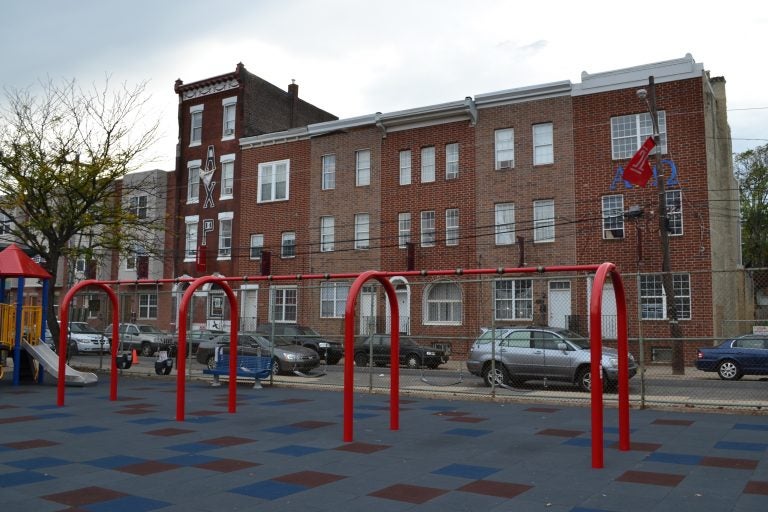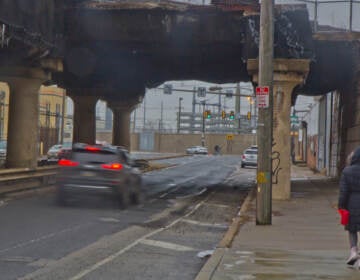Philly Federal Reserve study challenges conventional wisdom on gentrification
A new Philadelphia Federal Reserve study finds little evidence to support the idea that gentrification is massively disruptive to lower-income city residents.

Philadelphia Parks and Recreation and Council President Clarke unveiled the newly renovated Amos Playground (PlanPhilly, file)
This article originally appeared on PlanPhilly.
—
A new study from the Federal Reserve Bank of Philadelphia finds little evidence to support the conventional understanding of gentrification as a massively disruptive influence on the well-being of lower-income city residents.
“We find that neighborhoods that gentrify do seem to experience greater displacement, but there are important caveats,” Davin Reed, community economic development adviser at the Philadelphia Fed, said in an interview Monday. “They don’t move to neighborhoods that are higher in poverty or neighborhoods that are farther from the central business district, and they don’t pay more in rents.”
The study, which Reed co-wrote with Quentin Brummet of the University of Chicago, analyzed central city neighborhoods in the 100 largest U.S. metropolitan areas between the 2000 Census and the American Community Survey of 2010-2014. The paper defines gentrification as the process of college-educated individuals moving into low-income central city neighborhoods that previously housed few residents with advanced degrees.
Reed and Brummet’s research found that the amount of displacement that seems attributable to gentrification is relatively small. In the low-income neighborhoods they analyzed that did not gentrify, 68% of “original residents” with high school degrees or less moved over the course of the period of study. On average in gentrifying neighborhoods, the number who moved increased to 74%, which they attribute to displacement.
In addition, the researchers found, many low-income “original residents” remained in the neighborhood and benefited from the changing characteristics of the community. Perhaps obviously, low-income homeowners experience significant increases in their home values, while Reed and Brummet found that children from low-income households were more likely to go to college if they lived in gentrifying neighborhoods.
Their research finds that gentrification had no discernible effect on income, employment or commuting distance for lower-income original residents, both those who were displaced and those who remained. That finding undermines the most boosterish case for gentrification, while also showing that it doesn’t massively undercut the material quality of life for poorer residents.
Reed and Brummet’s research is notable, in part, because they are using difficult-to-access Census data that allows them to trace the fates of individual people who filled out both the 2000 Census and 2010-2014 American Community Survey. That enabled the researchers to show exactly where these people moved and how their lives changed with regard to such things as rent, income, and employment.
Reed and Brummet did not find a substantial amount of variation in gentrification effects across the metropolitan areas they studied. The big difference is not in what happens when a neighborhood gentrifies in Cleveland versus San Francisco, but in how many neighborhoods experience this kind of demographic change.
Washington, D.C., saw the highest levels of gentrification, the study found, with 40% of low-income neighborhoods experiencing this kind of demographic change. In some metro areas, like Detroit, only 0.7% of such neighborhoods gentrified.
Philadelphia experienced less dramatic change: 11% of the city’s low-income neighborhoods gentrified over the period of study.
“Philadelphia actually ends up in the middle,” said Reed. “It has 39 gentrifying neighborhoods, which is the fourth-highest in the country. But that’s really just because it’s a big city with a lot of neighborhoods that could have gentrified. Most didn’t. So it winds up 25th in our sample of 100 metro areas.”
The paper shows that much of the neighborhood demographic change was generated by newer, better-educated residents moving in rather than lower-income residents being forced out. That reinforces previous research, also released by the Philadelphia Federal Reserve, that found that demographic change in gentrifying neighborhoods was a result of typical levels of population churn in lower-income neighborhood — but with existing residents more often replaced by higher-income people than by similarly situated poor people
“Some people have referred to this as indirect displacement, where a neighborhood is no longer affordable to low-income people,” said Reed. “That’s a reason we think you shouldn’t just design policy to protect people who are already there. If you are in a world where people just move a lot, and this change is happening through replacement effects, maybe you should make sure people can afford to move there in the future.”
Reed doesn’t wade too much into the highly contentious debate on whether building more housing of any kind, including luxury homes, will help ease the effects of displacement (indirect or otherwise).
A spate of recent papers suggest that new construction can ease housing-cost increases in gentrifying neighborhoods, in some cases much faster than previously thought. But the field is extremely fraught, and some experts argue that the housing market is more segmented, so luxury construction — by increasing supply — will help ease housing costs in the higher end of the market but may do little for working-class residents. (Few suggest that the poorest residents will benefit from market-rate construction of any kind, because their incomes are often too low to reasonably accommodate any market-rate rent without subsidy.)
Reed said that more housing in high-demand urban neighborhoods is clearly part of the solution, but that a more targeted approach is needed to aid those who are most vulnerable.
“We also talk in the paper about complementing [more housing] with other policies like more directly subsidizing certain households, you could imagine subsidizing those at greatest risk for displacement or those with children who may benefit the most by living in these neighborhoods,” he said. “We think some combination of policies should be pursued to try to meet this rising demand, but just meeting that demand through supply isn’t the only way.”
WHYY is your source for fact-based, in-depth journalism and information. As a nonprofit organization, we rely on financial support from readers like you. Please give today.







